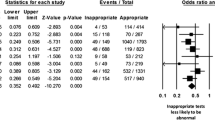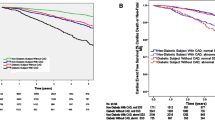Abstract
In 2016, the Journal of Nuclear Cardiology published many high-quality articles. Similar to previous years, we will summarize here a selection of the articles that were published in the Journal in 2016 to provide a concise review of the main advancements that have recently occurred in the field. In the first article of this two-part series we focused on publications dealing with positron emission tomography, computed tomography, and magnetic resonance. This review will place emphasis on myocardial perfusion imaging using single-photon emission-computed tomography summarizing advances in the field including in diagnosis, prognosis, and appropriate use.



Similar content being viewed by others
Abbreviations
- AUC:
-
Appropriate use criteria
- CAD:
-
Coronary artery disease
- CCTA:
-
Coronary-computed tomography
- CZT:
-
Cadmium-zinc-telluride
- DTS:
-
Duke Treadmill Score
- LAD:
-
Left anterior descending
- LVEF:
-
Left ventricular ejection fraction
- MI:
-
Myocardial infarction
- MPI:
-
Myocardial perfusion imaging
- TID:
-
Transient ischemic dilation
References
AlJaroudi WA, Hage FG. Review of cardiovascular imaging in the journal of nuclear cardiology in 2016. Part 1 of 2: Positron emission tomography, computed tomography, and magnetic resonance. J Nucl Cardiol 2017. doi:10.1007/s12350-017-0820-4.
AlJaroudi WA, Hage FG. Review of cardiovascular imaging in the journal of nuclear cardiology in 2014: Part 1 of 2: Positron emission tomography, computed tomography, and neuronal imaging. J Nucl Cardiol 2015;22:507-12.
Hage FG, AlJaroudi WA. Review of cardiovascular imaging in the journal of nuclear cardiology in 2014: Part 2 of 2: Myocardial perfusion imaging. J Nucl Cardiol 2015;22:714-9.
Shaw LJ, Hage FG, Berman DS, Hachamovitch R, Iskandrian A. Prognosis in the era of comparative effectiveness research: Where is nuclear cardiology now and where should it be? J Nucl Cardiol 2012;19:1026-43.
Cantoni V, Green R, Acampa W, Petretta M, Bonaduce D, Salvatore M, et al. Long-term prognostic value of stress myocardial perfusion imaging and coronary computed tomography angiography: A meta-analysis. J Nucl Cardiol 2016;23:185-97.
Naya M, Tamaki N. Stress MPI, coronary CTA, and multimodality for subsequent risk analysis. J Nucl Cardiol 2016;23:198-201.
Oldan JD, Shaw LK, Hofmann P, Phelan M, Nelson J, Pagnanelli R, et al. Prognostic value of the cadmium-zinc-telluride camera: A comparison with a conventional (Anger) camera. J Nucl Cardiol 2016;23:1280-7.
Karimeddini D, Bergmann S. The state of the future is solid. J Nucl Cardiol 2016;23:1288-90.
Poulin MF, Alexander S, Doukky R. Prognostic implications of stress modality on mortality risk and cause of death in patients undergoing office-based SPECT myocardial perfusion imaging. J Nucl Cardiol 2016;23:202-11.
Uretsky S. Beyond ischemia evaluation: The potential for assessing and addressing physical inactivity in the cardiac stress laboratory. J Nucl Cardiol 2016;23:212-4.
Gimelli A, Liga R, Pasanisi EM, Casagranda M, Coceani M, Marzullo P. Influence of cardiac stress protocol on myocardial perfusion imaging accuracy: The role of exercise level on the evaluation of ischemic burden. J Nucl Cardiol 2016;23:1114-22.
Spadafora M, Salvatore M, Cuocolo A. Stress protocol and accuracy of myocardial perfusion imaging: Is it better to start from the end? J Nucl Cardiol 2016;23:1123-7.
Nudi F, Schillaci O, Neri G, Pinto A, Procaccini E, Vetere M, et al. Prognostic impact of location and extent of vessel-related ischemia at myocardial perfusion scintigraphy in patients with or at risk for coronary artery disease. J Nucl Cardiol 2016;23:274-84.
Elhendy A. Prognostic significance of ischemia location on stress myocardial perfusion SPECT: Tracing the fingerprints of the widow maker. J Nucl Cardiol 2016;23:285-6.
El-Hajj S, AlJaroudi WA, Farag A, Bleich S, Manaoragada P, Iskandrian AE, et al. Effect of changes in perfusion defect size during serial regadenoson myocardial perfusion imaging on cardiovascular outcomes in high-risk patients. J Nucl Cardiol 2016;23:101-12.
Iskandrian AE, Roth CP, Hage FG. Serial imaging and outcome prediction. J Nucl Cardiol 2016;23:117-21.
Petretta M, Salvatore M, Cuocolo A. Immortality time and serial myocardial perfusion imaging: Only those who do not die may repeat the exam. J Nucl Cardiol 2016;23:113-6.
Iskandrian AE, Hage FG, Shaw LJ, Mahmarian JJ, Berman DS. Serial myocardial perfusion imaging: Defining a significant change and targeting management decisions. JACC Cardiovasc Imaging 2014;7:79-96.
Koh AS, Gao F, Chin CT, Keng FY, Tan RS, Chua TS. Differential risk reclassification improvement by exercise testing and myocardial perfusion imaging in patients with suspected and known coronary artery disease. J Nucl Cardiol 2016;23:366-78.
Yun HJ, Shah RV, Murthy VL. Exercise and Bayes’ Theorem: Some things never go out of style. J Nucl Cardiol 2016;23:379-83.
Eshtehardi P, Isiadinso I, Shaw LJ. The benefits of advanced risk reclassification. J Nucl Cardiol 2016;23:384-6.
Vitola JV, Wanderley MR Jr, Cerci RJ, Pereira Neto CC, Kormann O, Neto OF, et al. Outcome of patients with high-risk Duke treadmill score and normal myocardial perfusion imaging on spect. J Nucl Cardiol 2016;23:1291-300.
Matsumoto N, Hirayama A. Clinical value of high duke treadmill score with myocardial perfusion SPECT. J Nucl Cardiol 2016;23:1301-3.
Nakanishi R, Gransar H, Slomka P, Arsanjani R, Shalev A, Otaki Y, et al. Predictors of high-risk coronary artery disease in subjects with normal SPECT myocardial perfusion imaging. J Nucl Cardiol 2016;23:530-41.
Yokota S, Mouden M, Ottervanger JP. High-risk coronary artery disease, but normal myocardial perfusion: A matter of concern? J Nucl Cardiol 2016;23:542-5.
Bajaj NS, Singh S, Farag A, El-Hajj S, Heo J, Iskandrian AE, et al. The prognostic value of non-perfusion variables obtained during vasodilator stress myocardial perfusion imaging. J Nucl Cardiol 2016;23:390-413.
Golzar Y, Olusanya A, Pe N, Dua SG, Golzar J, Gidea C, et al. The significance of automatically measured transient ischemic dilation in identifying severe and extensive coronary artery disease in regadenoson, single-isotope technetium-99m myocardial perfusion SPECT. J Nucl Cardiol 2015;22:526-34.
Katz JS, Ruisi M, Giedd KN, Rachko M. Assessment of transient ischemic dilation (TID) ratio in gated SPECT myocardial perfusion imaging (MPI) using regadenoson, a new agent for pharmacologic stress testing. J Nucl Cardiol 2012;19:727-34.
Hage FG, Ghimire G, Lester D, McKay J, Bleich S, El-Hajj S, et al. The prognostic value of regadenoson myocardial perfusion imaging. J Nucl Cardiol 2015;22:1214-21.
Lester D, El-Hajj S, Farag AA, Bhambhvani P, Tauxe L, Heo J, et al. Prognostic value of transient ischemic dilation with regadenoson myocardial perfusion imaging. J Nucl Cardiol 2016;23:1147-55.
Loffler AI, Bourque JM. Prognostic impact of TID in regadenoson MPI: Some patients and certain events. J Nucl Cardiol 2016;23:1156-9.
Hage FG, Dean P, Iqbal F, Heo J, Iskandrian AE. A blunted heart rate response to regadenoson is an independent prognostic indicator in patients undergoing myocardial perfusion imaging. J Nucl Cardiol 2011;18:1086-94.
Hage FG, Dean P, Bhatia V, Iqbal F, Heo J, Iskandrian AE. The prognostic value of the heart rate response to adenosine in relation to diabetes mellitus and chronic kidney disease. Am Heart J 2011;162:356-62.
Mathur S, Shah AR, Ahlberg AW, Katten DM, Heller GV. Blunted heart rate response as a predictor of cardiac death in patients undergoing vasodilator stress technetium-99m sestamibi gated SPECT myocardial perfusion imaging. J Nucl Cardiol 2010;17:617-24.
Bellam N, Veledar E, Dorbala S, Di Carli MF, Shah S, Eapen D, et al. Prognostic significance of impaired chronotropic response to pharmacologic stress Rb-82 PET. J Nucl Cardiol 2014;21:233-44.
AlJaroudi W, Campagnoli T, Fughhi I, Wassouf M, Ali A, Doukky R. Prognostic value of heart rate response during regadenoson stress myocardial perfusion imaging in patients with end stage renal disease. J Nucl Cardiol 2016;23:560-9.
Andrikopoulou E, Hage FG. Heart rate response to regadenoson: Making the case for its value in clinical practice. J Nucl Cardiol 2016;23:575-80.
Brodov Y, Fish M, Rubeaux M, Otaki Y, Gransar H, Lemley M, et al. Quantitation of left ventricular ejection fraction reserve from early gated regadenoson stress Tc-99m high-efficiency SPECT. J Nucl Cardiol 2016;23:1251-61.
Sharir T, Brodkin B, Kovalski G. Combined assessment of myocardial perfusion and left ventricular function by nuclear cardiology: The value of high-efficiency SPECT. J Nucl Cardiol 2016;23:1262-5.
Elgendy IY, Mahmoud A, Shuster JJ, Doukky R, Winchester DE. Outcomes after inappropriate nuclear myocardial perfusion imaging: A meta-analysis. J Nucl Cardiol 2016;23:680-9.
George BJ, Aban IB. An application of meta-analysis based on DerSimonian and Laird method. J Nucl Cardiol 2016;23:690-2.
Beale C, Tilkemeier P. Understanding the past to appropriately guide us in the future. J Nucl Cardiol 2016;23:693-4.
Doukky R, Hayes K, Frogge N. Appropriate use criteria for SPECT myocardial perfusion imaging: Are they appropriate for women? J Nucl Cardiol 2016;23:695-705.
Druz RS. The feminine mystique of AUC. J Nucl Cardiol 2016;23:706-9.
Sharir T, Pinskiy M, Pardes A, Rochman A, Prokhorov V, Kovalski G, et al. Comparison of the diagnostic accuracies of very low stress-dose with standard-dose myocardial perfusion imaging: Automated quantification of one-day, stress-first SPECT using a CZT camera. J Nucl Cardiol 2016;23:11-20.
Duvall WL, Henzlova MJ. Nuclear cardiology as it should look in the twenty-first century. J Nucl Cardiol 2016;23:21-3.
van Dijk JD, Jager PL, Ottervanger JP, de Boer J, Oostdijk AH, Engbers EM, et al. Development and validation of a patient-tailored dose regime in myocardial perfusion imaging using conventional SPECT. J Nucl Cardiol 2016;23:134-42.
Thompson RC, Burgett EV. Patient centered imaging and the dose of radiopharmaceuticals. J Nucl Cardiol 2016;23:143-4.
Abidov A, Hachamovitch R, Hayes SW, Ng CK, Cohen I, Friedman JD, et al. Prognostic impact of hemodynamic response to adenosine in patients older than age 55 years undergoing vasodilator stress myocardial perfusion study. Circulation 2003;107:2894-9.
Bhatheja R, Francis GS, Pothier CE, Lauer MS. Heart rate response during dipyridamole stress as a predictor of mortality in patients with normal myocardial perfusion and normal electrocardiograms. Am J Cardiol 2005;95:1159-64.
Venkataraman R, Hage FG, Dorfman TA, Heo J, Aqel RA, de Mattos AM, et al. Relation between heart rate response to adenosine and mortality in patients with end-stage renal disease. Am J Cardiol 2009;103:1159-64.
Hage FG, Perry G, Heo J, Iskandrian AE. Blunting of the heart rate response to adenosine and regadenoson in relation to hyperglycemia and the metabolic syndrome. Am J Cardiol 2010;105:839-43.
Iqbal FM, Al Jaroudi W, Sanam K, Sweeney A, Heo J, Iskandrian AE, et al. Reclassification of cardiovascular risk in patients with normal myocardial perfusion imaging using heart rate response to vasodilator stress. Am J Cardiol 2013;111:190-5.
Disclosure
Dr. Hage reports grant support from Astellas Pharma and Novartis Pharma.
Author information
Authors and Affiliations
Corresponding author
Rights and permissions
About this article
Cite this article
Hage, F.G., AlJaroudi, W.A. Review of cardiovascular imaging in the journal of nuclear cardiology in 2016: Part 2 of 2—myocardial perfusion imaging. J. Nucl. Cardiol. 24, 1190–1199 (2017). https://doi.org/10.1007/s12350-017-0875-2
Received:
Accepted:
Published:
Issue Date:
DOI: https://doi.org/10.1007/s12350-017-0875-2




